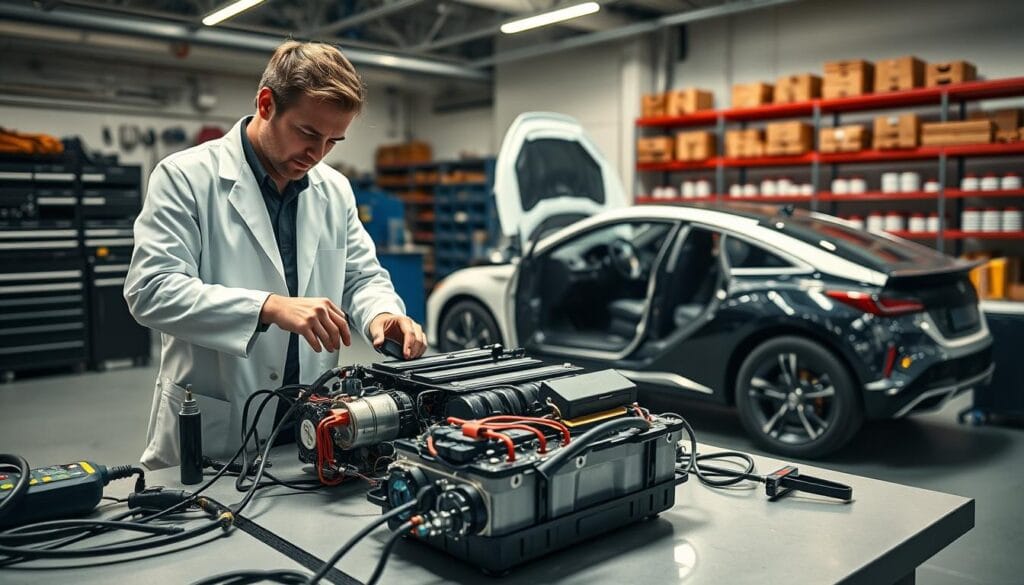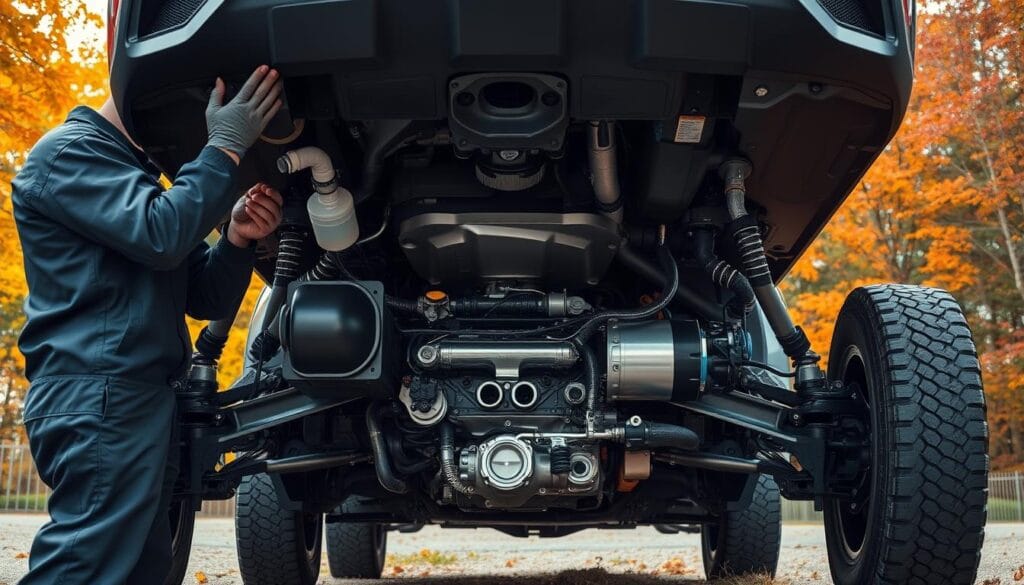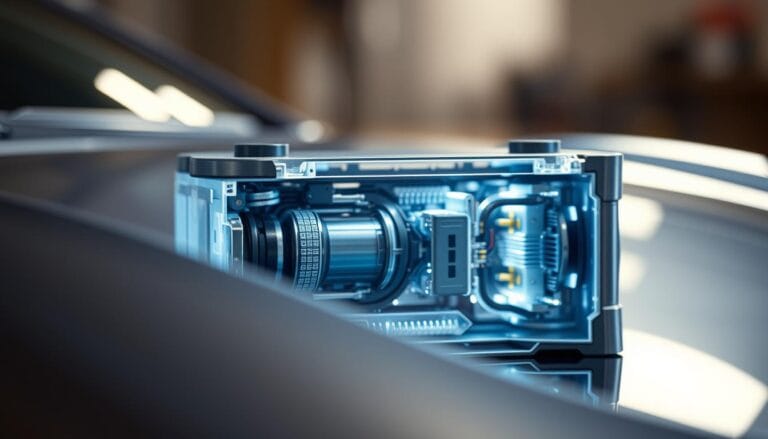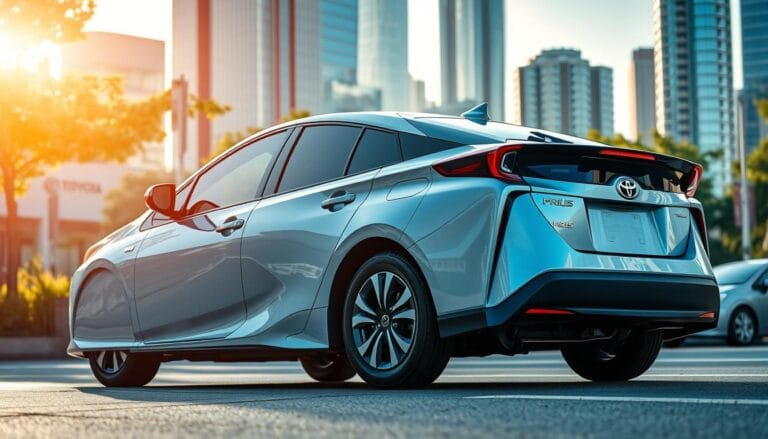Hybrid Transmission Tips: Maintenance Made Easy
The first time I saw a hybrid vehicle, I was blown away. It smoothly mixed electric and gasoline power. As a car lover, I learned that taking care of a hybrid is different from regular cars.
Knowing how to maintain your hybrid is key. It’s a mix of electric and gasoline, needing special care. This ensures it runs well and lasts long.
Looking after your hybrid is more than just keeping it in good shape. It’s about knowing how it works – Hybrid Transmission Tips. Things like regenerative braking and battery care need attention. This keeps your eco-friendly car running great.
Table of Contents
Understanding Hybrid Transmissions
Hybrid vehicles are a big step forward in car technology. They mix traditional engines with electric powertrains. Knowing how hybrid transmission systems work is key for today’s drivers.
Hybrid powertrains are amazing feats of engineering. They use different energy sources to be more efficient. These systems have many parts that work together for the best performance.
What Makes Hybrid Transmissions Unique?
Hybrid transmissions are very different from regular car systems. They use special technologies:
- Continuous variable transmissions (eCVT) instead of standard gear systems
- Integrated electric motors alongside combustion engines
- Advanced energy recovery mechanisms
The fluid used in hybrid transmissions is very important. It helps manage heat, cuts down on friction, and makes power transfer smooth.
Key Components of a Hybrid System
A hybrid powertrain has a few main parts:
- Electric Motor: Adds power and lets cars drive on electric alone
- Battery Pack: Holds electrical energy for moving the car
- Power Split Device: Controls how energy is shared between sources
- Regenerative Braking System: Turns braking energy into electricity
With 43% of U.S. sales being hybrids in 2024, it’s vital to understand these systems. They offer efficient and eco-friendly ways to travel.
Benefits of Hybrid Transmissions
Hybrid vehicles are a game-changer in car technology. They offer big advantages for drivers and the planet. By using both electric and gasoline power, they provide amazing benefits.
Fuel Efficiency Advantages
Hybrid cars can get up to 50-60 miles per gallon. This is way better than regular cars, which usually get 25-30 MPG. The special design of hybrid transmissions helps a lot.
- They use less fuel.
- They cost less to drive.
- They manage energy better.
Reduced Emissions Impact
Hybrid cars cut down on greenhouse gas emissions by 30-50%. This is a big deal for our planet. They make driving more eco-friendly and reduce harm to the environment.
*Hybrid vehicles are not just transportation – they’re a commitment to a cleaner planet.*
Performance Benefits of Hybrid Technology
Hybrid cars perform really well. They can recover up to 70% of energy lost during braking. Plus, electric motors are very quiet, around 40 decibels.
- They accelerate 15-20% faster.
- They’re up to 20% more efficient.
- They drive smoother.
By taking good care of your hybrid, you can enjoy these benefits for a long time.
Regular Maintenance for Hybrid Vehicles
To keep your hybrid vehicle in great shape, you need a smart maintenance plan. It’s not just about fixing issues; it’s about stopping them before they start. Your hybrid’s special design needs special care to run well and last long.
Looking after a hybrid car is different from regular car care. These cars mix gasoline engines with electric motors. This makes a complex system that needs regular checks from experts.
Importance of Routine Checks
Regular maintenance helps find problems early, saving you money. Hybrid Transmission Repair experts suggest checking these key areas:
- Transmission fluid levels and condition
- Battery health and performance
- Cooling system functionality
- Software and electronic system updates
- Brake system inspections
Recommended Maintenance Schedule
Your hybrid’s maintenance schedule is different from other cars. Here’s a detailed guide to keep your hybrid running well:
- Every 5,000-10,000 miles: Tire rotation and balance
- Every 7,500-10,000 miles: Oil and filter changes
- Twice annually: Complete system check
- Annually: Battery performance test
By sticking to these tips, you’ll boost your hybrid’s efficiency. You’ll also cut down on Hybrid Transmission Repair costs. And you’ll enjoy a reliable ride every time you get behind the wheel.
Common Issues with Hybrid Transmissions
When it comes to hybrid transmissions, you need to watch for warning signs. These signs can tell you if something’s wrong. Keeping your hybrid’s transmission in top shape is key to its performance and life.
Knowing what to look for can help you avoid big repair bills. Spotting problems early is important. It helps keep your hybrid running smoothly.
Signs of Transmission Problems
Here are the warning signs you should watch for:
- Unusual noises during gear shifts
- Unexpected jerking or vibrations
- Decreased fuel efficiency
- Check engine light activation
- Difficulty switching between electric and gasoline power
Diagnosing Hybrid Transmission Issues
Diagnosing hybrid transmission problems needs a careful plan. Here are some steps to follow:
- Check transmission fluid levels and condition
- Use specialized diagnostic tools
- Monitor battery performance
- Listen for unusual sounds during operation
*Proactive maintenance can prevent up to 70% of hybrid transmission problems.*
| Issue Type | Frequency | Potential Cost |
|---|---|---|
| CVT Transmission Problems | 8% of maintenance cases | $3,000 – $11,000 |
| Battery-Related Issues | 20% of vehicle problems | $1,500 – $6,000 |
| Regenerative Braking System | 15% of maintenance concerns | $500 – $2,500 |
Early detection is key in hybrid transmission diagnosis. Regular checks and maintenance can make your hybrid last longer. It also saves you from expensive fixes.
Fluid Changes for Hybrid Transmissions
Keeping the right hybrid transmission fluid is key for your car’s health and life span. Hybrid cars need special care for their fluid systems, unlike regular cars.
Your hybrid car’s transmission needs special fluids to run smoothly. Knowing when and how to change these fluids can save you from expensive fixes and keep your car running longer.
Essential Hybrid Transmission Fluid Types
- Specialized synthetic transmission fluid
- Manufacturer-recommended coolant
- Specific hybrid transmission lubricants
Fluid Change Intervals
How often you need to change transmission fluid depends on your car model. Here are some general tips:
- Check fluid levels every month
- Change fluids every 50,000 to 100,000 miles
- Always follow what the maker says
Warning Signs for Fluid Replacement
Look out for these signs that your Hybrid Transmission Fluid needs a change:
- Burning smell from transmission
- Difficulty shifting gears
- Unusual grinding noises
- Dark or contaminated fluid color
Getting your car checked by a pro can stop big problems and keep your hybrid running great. Always check your car’s manual for the best times and ways to change fluids.
Battery Maintenance and Hybrid Performance
Your hybrid vehicle’s battery is key to its power. Keeping the battery healthy is vital for the best Hybrid Transmission Lifespan and performance. A good battery boosts your car’s efficiency and life.

Knowing your hybrid battery’s role is important. It affects your Hybrid Powertrain’s performance. Hybrid batteries need special care and attention.
Importance of Battery Health
Battery health affects your hybrid’s performance and fuel use. Here are some key points:
- Hybrid car batteries last 160,000 to 240,000 kilometers
- They work for 8 to 10 years
- Replacing them costs $2,000 to $8,000
Tips for Maintaining Your Hybrid Battery
Take care of your battery with these tips:
- Regular Inspections: Get battery system checks every 40,000 kilometers
- Watch battery temperature and avoid extreme conditions
- Drive smoothly to lessen battery stress
- Keep battery connections clean and tight
- Avoid deep discharges often
Get professional checks to see how your battery is doing. Follow these tips to keep your hybrid running well and extend your battery’s life.
Diagnostic Tools for Hybrid Transmissions
Fixing hybrid transmissions needs special tools and knowledge. Whether you’re doing it yourself or getting help, the right approach saves time and money.
Modern hybrids have complex electronic systems. The right tools are key to keeping your transmission running well.
Essential Tools for Hybrid Transmission Diagnosis
- OBD2 Scanner with Hybrid-Specific Capabilities
- Digital Multimeter
- Transmission Fluid Pressure Gauge
- Diagnostic Laptop or Tablet
- Specialized Hybrid Transmission Diagnostic Software
DIY vs. Professional Hybrid Transmission Repair
Some fixes can be done at home, but complex problems need a pro. The Innova 5210 is a good DIY tool, priced at $79.99 after a 20% discount.
Experts use tools like the Allison DOC® Premium for detailed checks. It supports many transmission types and gives deep insights.
| Diagnostic Approach | Pros | Cons |
|---|---|---|
| DIY Diagnosis | Lower cost, basic troubleshooting | Limited diagnostic capabilities |
| Professional Diagnosis | Comprehensive analysis, expert insights | Higher cost, requires scheduling |
Always be safe when diagnosing hybrid transmissions. For tough problems, get a pro. Use good tools and know what your car needs.
Finding a Trusted Hybrid Mechanic
Choosing the right mechanic for your hybrid car is key to keeping it running well. Hybrid cars need special care that not all mechanics know how to give.
Finding the right mechanic for your hybrid car can be tough. The right choice can greatly affect your car’s health and how well it runs.
Key Qualifications to Seek
- Certifications in hybrid and electric vehicle repair
- Specialized training from makers like Toyota, Honda, or Ford
- Advanced diagnostic tool skills
- Proven experience with Hybrid Vehicle Maintenance
- Good customer reviews and ratings
Critical Questions to Ask
- What specific hybrid training have you completed?
- Do you have experience with my specific hybrid model?
- What diagnostic tools do you use for hybrid systems?
- Can you provide references from previous hybrid vehicle clients?
“Not all mechanics are created equal when it comes to hybrid technology.” – Hybrid Vehicle Expert
When looking for a reliable hybrid mechanic, check local shops with great reviews. For example, Hogan Tire & Auto in Woburn, MA, has a 4.6 out of 5 stars rating from 527 reviews. This shows how important customer happiness is in car services.
Hybrid cars have special parts like high-voltage batteries and electric motors. They need special training for the right fixes. Taking the time to find the right mechanic can save you money and avoid expensive repairs.
Preparing for Seasonal Changes
Hybrid vehicles need special care during seasonal changes. Your hybrid powertrain needs unique maintenance to work best all year. Knowing how temperature changes affect your car helps avoid problems and keeps it running smoothly.

Winter Driving Tips for Hybrids
Cold weather is tough on hybrid cars. It can hurt your car’s battery and how it drives. Here are key tips for winter:
- Check tire pressure often, as it goes down with the temperature
- Keep your battery charged and warm
- Use special windshield fluid for clear views
- Have an emergency kit ready with winter essentials
Batteries in hybrids lose a lot of power in cold. At 32°F, they can lose up to 35% of their strength, and at 0°F, it’s 60%. Keeping your battery warm and charged is key for good performance.
Summer Maintenance Considerations
Summer also has its own needs for hybrid cars. Hot weather can stress your car’s system. Here are important summer tips:
- Make sure coolant levels are right
- Check tire tread and alignment
- Ensure brakes work well
- Keep battery away from too much heat
Regular care can stop up to 75% of car troubles. By adjusting your car care for the seasons, you’ll get better performance and longer life.
Hybrid Transmission Upgrades
Keeping your hybrid vehicle in top shape is key. Upgrading your hybrid transmission can make your car last longer and drive better. Knowing when and how to upgrade can save you money and improve your car’s efficiency.
When to Consider Upgrades
It’s important to know when to replace or rebuild your hybrid transmission. Look out for these signs:
- Decreased fuel efficiency
- Unusual transmission noises
- Reduced electric mode performance
- Vehicle age over 100,000 miles
- Consistent warning lights
Popular Performance Upgrades
Hybrid cars offer great upgrade options to boost performance and efficiency. Here are some top picks:
| Upgrade Type | Performance Impact | Estimated Cost |
|---|---|---|
| Software Update | Enhanced power management | $150-$300 |
| Battery Module Replacement | Improved electric range | $500-$2,000 |
| Transmission Control Module | Optimized shift patterns | $300-$750 |
“Investing in strategic hybrid transmission upgrades can transform your driving experience while maintaining long-term vehicle health.” – Automotive Performance Expert
Modern hybrid tech, like ZF’s TraxOn 2 transmission, can cut CO2 emissions a lot. Smart upgrades can help you use these advanced technologies well.
Remember, regular maintenance and timely upgrades are essential. They help keep your hybrid car running well, efficiently, and for a long time.
Cost of Maintaining a Hybrid Transmission
Knowing the costs of owning a hybrid is key for both new and current owners. Hybrid car upkeep has its own set of expenses, unlike regular cars. It’s vital to budget well for these costs.
Average Maintenance Expenses
Repair and replacement costs for hybrid transmissions have dropped a lot. Today’s hybrids are more affordable to maintain than older models. Here are the typical costs for hybrid transmission services:
- Routine maintenance: $200 – $500 annually
- Hybrid Transmission Repair: $800 – $2,500
- Hybrid Transmission Replacement: $2,000 – $4,500
Budgeting for Hybrid Repairs
Preparing your finances for hybrid car upkeep is important. Here are some budget tips:
- Save $50-$100 monthly for repair costs
- Look into extended warranties for full coverage
- Keep track of your car’s maintenance history
Many hybrid makers offer long warranties, sometimes up to 10 years or 100,000 miles. The cost of hybrid batteries has also fallen, from about $8,000 to over $2,000. This makes owning a hybrid more cost-effective over time.
Regular maintenance can greatly lower unexpected repair costs for hybrid transmissions.
By keeping up with maintenance and knowing your hybrid’s needs, you can save money. This also helps your car last longer.
Resources for Hybrid Transmission Information
Understanding hybrid vehicle maintenance can be tough. But, many resources are out there to help you learn. Online communities are great for sharing tips and solving problems with hybrid vehicles.
There are special forums and websites for hybrid tech talks. Sites like PriusChat, GreenHybrid, and Reddit’s hybrid subreddits are full of info. They cover models like Ford’s Explorer and Lincoln Aviator hybrids. You can learn from owners of different hybrid types.
For deep knowledge, check out professional guidebooks and manuals. Ford and Mazda offer detailed insights into hybrid systems. Look for books on regenerative braking and electric drive units to understand hybrid powertrains better.
Online Communities and Forums
Joining online hybrid communities keeps you up-to-date. Websites like CleanMPG and PriusChat have discussion boards. Experienced owners share their knowledge to help newcomers.
Recommended Books and Guides
Invest in guides that dive into hybrid tech. Look for books that explain hybrid drive units and electric motor performance. Technical manuals from manufacturers and experts give the latest info on hybrid maintenance.







